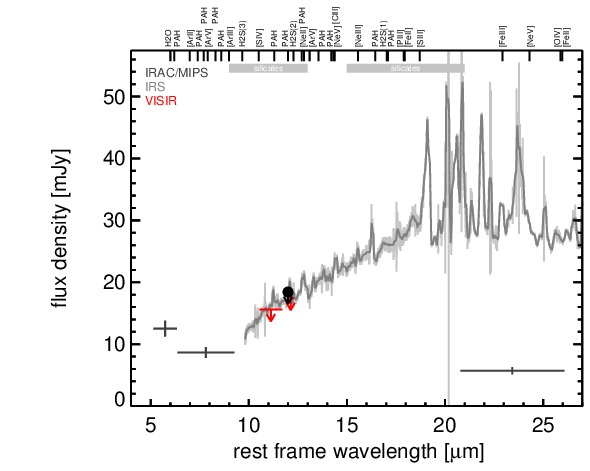Sasmirala Individual Information for NGC 7626
Description
NGC 7626 is a peculiar giant elliptical galaxy at a redshift of z = 0.0114 (D ~ 45.4 Mpc) with a FR I radio morphology and a possibly active LINER nucleus [ho_search_1997-1]. Its detection in X-rays is reported by [ho_radiatively_2009]. At radio wavelengths, a compact core with a prominent biconical kiloparsec-scale radio jet has been found (PA~ 35∘; [birkinshaw_orientations_1985, nagar_radio_2005]. These evidence heavily support the presence of an AGN in NGC 7626. Furthermore, a nuclear warped dust lane with ~ 1arcsec ~ 216 pc extent obscures the nucleus in the north-south direction (PA~ 167∘;[forbes_ellipticals_1995, verdoes_kleijn_hubble_1999]). NGC 7626 remained undetected in the MIR with IRAS and ground-based IRTF observations [sparks_infrared_1986]. The first MIR detection could be achieved with ISO [ferrari_survey_2002, temi_ages_2005], followed by Spitzer/IRAC, IRS and MIPS observations. The corresponding IRAC and MIPS images show extended elliptical emission without a clearly separable unresolved nuclear component. In addition, two compact emission sources are visible in the IRAC 8.0 μm images at distances ~ 7arcsec ~ 1.5 kpc north-east and ~ 5arcsec ~ 1 kpc south-west of the nucleus (PA~ 16∘). These might be related to the large-scale jets. Our nuclear MIPS 24 μm photometric flux is significantly lower than the total flux given in [temi_spitzer_2009]. The IRS HR staring-mode spectrum suffers from low S/N and does not indicate any spectral features apart from possibly PAH emission. Note also that no background subtraction was performed for this spectrum. [dudik_spitzer_2009] provide upper limits on the [Ne V] and [O IV] high-ionization lines. The IRAC and MIPS photometry is more trustworthy and resembles a blue arcsecond-scale MIR SED of a rather passive galaxy [bressan_spitzer_2006]. We observed NGC 7626 with VISIR in two narrow N-band filters in 2009 [asmus_mid-infrared_2011] but failed to detect any MIR emission. Our new measurement routines provide more constraining upper limits, which, however, are still insufficient to reach any conclusions about the existence of a weak AGN in NGC 7626 from the MIR point of view.
- [asmus_mid-infrared_2011] D. Asmus, P. Gandhi, A. Smette, S. F. Hönig, and W. J. Duschl. Mid-infrared properties of nearby low-luminosity AGN at high angular resolution . A&A , 536 pp. 36, December 2011.
- [birkinshaw_orientations_1985] M. Birkinshaw and R. L. Davies. The orientations of the rotation axes of radio galaxies. i - radio morphologies of bright elliptical galaxies . ApJ , 291 pp. 32–44, April 1985.
- [bressan_spitzer_2006] A. Bressan, P. Panuzzo, L. Buson, M. Clemens, G. L. Granato, R. Rampazzo, L. Silva, J. R. Valdes, O. Vega, and L. Danese. Spitzer IRS spectra of virgo early-type galaxies: Detection of stellar silicate emission . ApJL , 639 pp. L55–L58, March 2006.
- [dudik_spitzer_2009] R. P. Dudik, S. Satyapal, and D. Marcu. A spitzer spectroscopic survey of low-ionization nuclear emission-line regions: Characterization of the central source . ApJ , 691 pp. 1501–1524, February 2009.
- [ferrari_survey_2002] F. Ferrari, M. G. Pastoriza, F. D. Macchetto, C. Bonatto, N. Panagia, and W. B. Sparks. Survey of the ISM in early-type galaxies. IV. the hot dust component . A&A , 389 pp. 355–366, July 2002.
- [forbes_ellipticals_1995] Duncan A. Forbes, Marijn Franx, and Garth D. Illingworth. Ellipticals with kinematically distinct cores: WFPC1 imaging of nearby ellipticals . AJ , 109 pp. 1988, May 1995.
- [ho_radiatively_2009] Luis C. Ho. Radiatively inefficient accretion in nearby galaxies . ApJ , 699 pp. 626–637, July 2009.
- [ho_search_1997-1] Luis C. Ho, Alexei V. Filippenko, and Wallace L. W. Sargent. A search for ``Dwarf'' seyfert nuclei. III. spectroscopic parameters and properties of the host galaxies . ApJS , 112 pp. 315, October 1997.
- [nagar_radio_2005] N. M. Nagar, H. Falcke, and A. S. Wilson. Radio sources in low-luminosity active galactic nuclei. IV. radio luminosity function, importance of jet power, and radio properties of the complete palomar sample . A&A , 435 pp. 521–543, May 2005.
- [sparks_infrared_1986] W. B. Sparks, J. H. Hough, D. J. Axon, and J. Bailey. Infrared photometry of the nuclei of early-type radio galaxies . MNRAS , 218 pp. 429–444, February 1986.
- [temi_ages_2005] Pasquale Temi, William G. Mathews, and Fabrizio Brighenti. The ages of elliptical galaxies from mid-infrared emission . ApJ , 622 pp. 235–243, March 2005.
- [temi_spitzer_2009] Pasquale Temi, Fabrizio Brighenti, and William G. Mathews. Spitzer observations of passive and star-forming early-type galaxies: An infrared color-color sequence . ApJ , 707 pp. 890–902, December 2009.
- [verdoes_kleijn_hubble_1999] Gijs A. Verdoes Kleijn, Stefi A. Baum, P. Tim de Zeeuw, and Chris P. O'Dea. Hubble space telescope observations of nearby radio-loud early-type galaxies . AJ , 118 pp. 2592–2617, December 1999.
Images

Optical image (DSS, red filter). Displayed are the central 4 arcmin with North being up and East to the left. The colour scaling is linear with white corresponding to the median background (BG) and black to the 0.01% pixels with the highest intensity.

Spitzer MIR images. Displayed are the inner 40 arcsec with North being up and East to the left. The colour scaling is logarithmic with white corresponding to median BG and black to the 0.1% pixels with the highest intensity. The label in the bottom left states instrument and central wavelength of the filter in micron (I: IRAC, M: MIPS).
SEDs


MIR SED. The description of the symbols in all the SED plots (where present) is the following: Grey crosses and solid lines mark the Spitzer/IRAC, MIPS and IRS data. The colour coding of the other symbols is as follows: green for COMICS, magenta for Michelle, blue for T-ReCS and red for VISIR data. Darker-coloured solid lines mark spectra of the corresponding instrument. The black filled circles mark the nuclear 12 and 18 micron continuum emission estimate from the data (where present). The ticks on the top axis mark positions of common MIR emission lines, while the light grey horizontal bars mark wavelength ranges affected by the silicate 10 and 18 micron features.